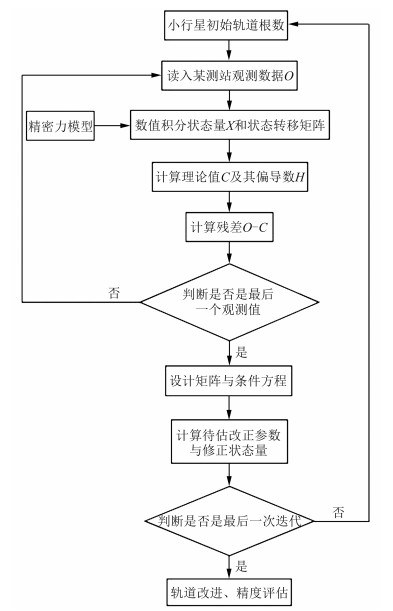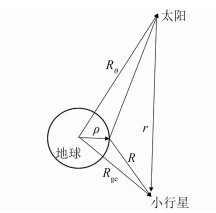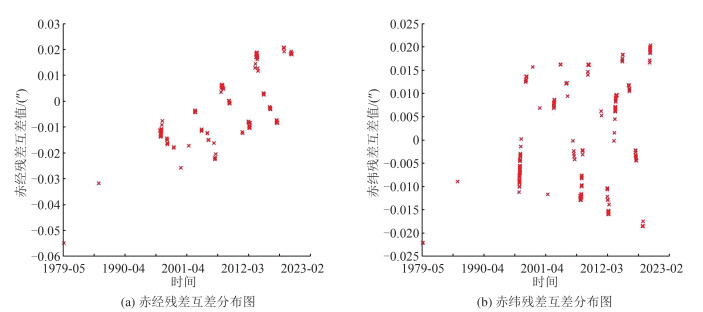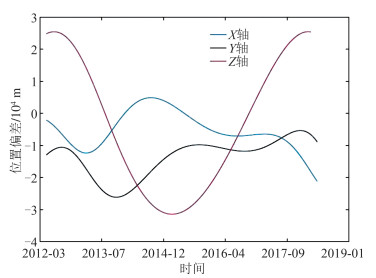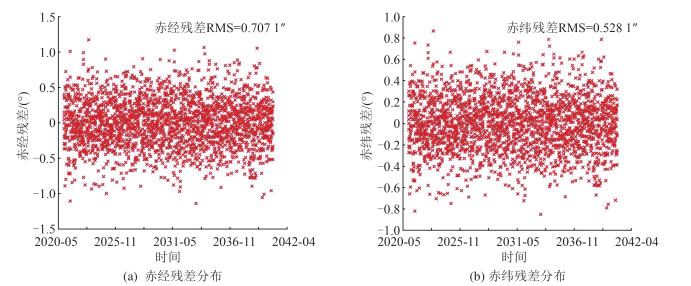Development of Asteroid Optical Determination Software and Data Processing Analysis
-
摘要:
结合中国航天局2019-04-19拟定的第1个小行星探测任务规划,针对任务目标之一的主带彗星133P/Elst-Pizarro(7968)自主研制了小行星光学定轨软件。使用1979-07-24—2019-10-28发布的133P/Elst-Pizarro地面光学观测数据进行精密定轨,与国际知名小行星光学定轨软件OrbFit进行对比分析。对比发现,解算结果残差分布一致,两软件生成的残差均方根的差值小于0.01″,定轨的内符合精度相互吻合。该结果初步表明,自主研制的小行星光学定轨程序可靠。在此基础上,对133P/Elst-Pizarro开展光学数据仿真定轨分析,研究地面光学数据的定轨精度。结果表明,模拟中国云南站和智利站每月一次联测,在只考虑观测噪声影响的情况下,添加接近目前实际观测水平的高斯白噪声,使用20 a光学观测资料定轨,小行星光学定轨精度在50 km量级。同时验证, 增加观测数据或降低观测噪声均可有效提高小行星光学定轨精度。
-
关键词:
- 主带彗星133P/Elst-Pizarro /
- 光学定轨 /
- 仿真分析 /
- 精度分析
Abstract:ObjectivesBased on the first asteroid exploration plan announced by China Space Administration on April 19, 2019, the main belt comet 133P/Elst-Pizarro (7968) is one of the possible mission targets. We aim to report integrated orbital fits for 133P through all the available ground-based optical data.
MethodsWe developed an optical orbit determination software and compared it with the well-known OrbFit software system. The 133P/Elst-Pizarro's ground-based optical observation data from July 24, 1979 to October 28, 2019 were analyzed. In addition, we carried out a simulation orbit determination analysis aimed at 133P/Elst-Pizarro to discuss the orbit determination accuracy from ground-based optical data.
ResultsAfter the fitting process, the residual distribution of 133P ground-based optical data is consistent between our results and the results from OrbFit. The measurement statistical residual root mean square (RMS) is less than 0.01″, and the internal coincidence accuracy of orbit determination is also consistent with each other. In our simulation experiments, we used 20-year simulation optical observation data measured once a month from Yunnan station and Chile station. The data were also added with Gaussian white noise which is close to the current actual observation level. The results of our simulation experiments reflected that the optical orbit determination accuracy of the asteroid was at 50 km level.
ConclusionsThe processing results of 133P optical data suggests the reliability of our software. Further simulation analysis shows that the optical orbit determination accuracy of the asteroid can be effectively improved by increasing the observation data or reducing the observation noise.
-
2017年中共中央办公厅、国务院办公厅印发了《关于建立资源环境承载能力监测预警长效机制的若干意见》,明确建立健全资源环境承载力监测与预警体系是推进中国生态文明建设的关键环节。而资源环境承载力精细评价技术与方法的研究是构建该体系的核心内容,也逐步得到越来越多学者的关注。
国内学者围绕资源环境承载力的基础理论、评价方法及实践应用等方面,在国家级、区域级、城市级等不同尺度下对土地[1-3]、水[4]、环境要素[5]、生态[6]等单项以及综合的资源环境承载力评价及其预警机制[7]进行了丰富的研究与探索。其中,在中国城镇化进程高速推进的背景下,城市土地资源逐步成为城市发展的核心资源要素[8],土地资源承载力研究从传统的关注农业生产更多地转向其对城市化过程的约束作用。但是,以往研究多以指标体系探索为主,在评价方法方面多以宏观的全局统计为主,不能满足评价区域从全国、区域尺度研究聚焦到城市级单元时进行精细尺度分析评价的需求[9]。
值得注意的是,在地理学研究中,空间变量及其关系在不同位置或区域可能呈现复杂、多样、各异的过程、现象或规律,即空间异质性或非平稳性特征[10]。1996年,地理加权回归分析(geographically weighted regression,GWR)技术被提出[11],区别于单一普适建模的传统空间统计分析方法,通过因地制宜式的空间变参数估计实现空间变量及其关系的精细化局部视角分析[12],将关于空间关系异质性特征的研究推向一个新的阶段。随着GWR技术的发展,涌现了广义GWR(generalized GWR)[13]、地理加权序数回归分析(geographically weighted ordinal regression, GWOR)[14]、多尺度GWR[15-16]和时空GWR(geographically and temporally weighted regression, GTWR)[17]等技术扩展;与此同时,还出现了一系列其他地理加权类技术,如地理加权汇总统计(geographically weighted summary statistics,GWSS)[18]、地理加权主成分分析(geographically weighted principal components analysis, GWPCA)[19]和地理加权判别分析(geographically weighted discriminant analysis,GWDA)[20]等,形成了能够满足不同层次需要的空间计量分析技术体系。但是,目前地理加权建模技术的应用仍多以单一使用为主[21],未能充分发挥不同技术之间的互补特性,而土地资源环境承载力评价与分析为其集成应用提供了一个绝佳的应用场景。
本文针对城市土地资源承载力,以武汉市为例,探索利用地理加权建模技术贯穿整个评价过程,提供精细尺度分析评价结果,以期为城市土地资源承载力分析评价提供新的技术思路与分析视角,同时也侧面反映地理加权建模技术的集成应用效果。
1 地理加权建模技术
地理加权建模技术的本质是采用关于位置的求解,按照地理学第一定律所呈现的距离衰减规律进行权重计算,进而通过关于空间位置变化的参数估计量化表征空间变量及其关系的异质性或非平稳性特征[21]。常用地理加权建模技术主要包括GWSS、GWPCA、GWR等技术,在地理国情分析评价中发挥不同的作用。
GWSS技术主要指采用地理加权思想对基础汇总统计量进行计算,如均值、标准差、协方差和相关性系数,其计算式分别为:
(1) (2) (3) (4) 式中,
分别为位置i处的自变量和因变量取值; 为空间权重[21]; 为变量 的地理加权均值; 、 分别为变量 和y的地理加权标准差; 、 分别为变量 和y的地理加权协方差和地理加权协相关系数。GWSS技术聚焦于一元或二元空间变量关系分析,可用于地理国情指标及其影响因素的探索性分析过程。 相比于传统的主成分分析技术,GWPCA技术对关于位置的地理加权方差-协方差矩阵进行正交分解,以计算对应位置的特征值与特征向量,其计算式分别为:
(5) (6) 式中,
为空间权重矩阵; 为位置i处变量矩阵X的地理加权方差-协方差矩阵; 为由 特征值构成的对角矩阵; 为特征向量矩阵。GWPCA技术可以识别变量空间各个主成分载荷的局部空间变化,更好地体现关于位置的横截面属性数据异质性构成,能够进行更加准确的综合评价指标计算。 基础GWR模型一般可表达为:
(7) 式中,
为截距项; 为回归分析系数。GWR技术通过关于位置的求解,量化估计一元或多元自变量与因变量之间的关系,契合多样、复杂的评价指标分析评价场景,尤其能够在针对特定指标变量的影响要素或成因分析过程中发挥重要作用。 综上,GWSS、GWPCA和GWR技术覆盖了不同层次的空间数据分析需求,提供了随着空间位置而变化的量化分析视角,能够较好地满足日趋多元、精细、准确的地理国情分析评价需要,随着地理加权建模技术的不断丰富与拓展,这个技术体系的优势与特点将得到进一步凸显。
2 城市土地资源承载力评价
本文以2019年武汉市主城建成区范围内的土地承载力评价为例,采用基于地理加权建模的方法流程评价主建成区街道级土地承载压力状况,并结合相关要素进行成因分析。本文所采用的评价流程如图1所示,其中AHP(analytic hierarchy process)为层次分析法。
如图1所示,本文采用武汉市地理国情监测数据、统计数据、专项调查数据以及新的时空大数据等多源数据,从人口、经济、建设和交通4个方面对城市土地资源承载力进行评价。这四类要素通常被认为是城市系统研究的核心元素,其分布大体上能够反映城市空间利用情况。人口和经济是地理国情监测中常见的社会经济专题数据,建设和交通要素与城市化、存量土地利用等专题相关,基于这4个方面进行土地承载力分析评价基本能够满足地理国情监测中资源环境承载力和国土空间开发适宜性评价的需求。
本文各项指标统计以建成区范围内的街道区域为统计单元,因此需要采用尺度上推和下推等技术对多源时空数据进行融合操作,进而完成街道单元的评价指标计算。
以经济指标为例,其数据来源为武汉市统计年鉴数据,需要采用尺度下推技术实现街道单元的经济指标计算[22]。具体来说,本文所需的街道国内生产总值(gross domestic product,GDP)数据可分为每个街道内一产、二产和三产增加值之和,根据每个街道单元内各类产业用地面积占比,对统计年鉴中所提供的区级经济数据进行折算与汇总。街道GDP数据尺度下推规则的计算式为:
(8) 式中,
表示街道尺度GDP; 为区第一产业增加值; 、 分别表示街道和区级单元的第一产业用地面积占比; 为区第二产业增加值; 、 分别表示街道和区级单元的第二产业用地面积占比; 为区第三产业增加值; 、 分别表示街道和区级单元的第二产业用地面积占比。 本文采用的产业用地数据主要来自于地理国情监测和专项调查数据,其详细说明见表1。
表 1 各类产业用地数据说明Table 1. Land Data Description of Each Industry产业类型 产业用地数据 第一产业 地表覆盖分类中的耕地、园地 第二产业 工业用地、地理国情城镇功能单元中的工矿企业 第三产业 第三产业增加值包括教育医疗、交通运输仓储和邮政业、批发和零售业、住宿和餐饮业、金融业、房地产业、其他服务业 2.1 土地资源承载压力评价
2.1.1 单项评价
本文从人口、经济、建设和交通四类土地承载对象出发,对城市土地承载压力构建指标体系分别进行单项评价,在此基础上采用PCA和AHP选取典型单项指标,包括常住人口密度、地均GDP、容积率、建筑密度和拥堵里程占比进行土地资源承载压力综合集成评价,其评价指标如表2所示。本文所使用的专题数据时间点统一为2018年12月底。
表 2 土地承载压力指标Table 2. Indices of Land Resource Carrying Pressure评价指标 城市生活空间 工业生产空间 人口 常住人口密度 就业(三产)人口密度 就业(二产)人口密度 流动人口密度 经济 地均GDP(三产为主) 地均GDP(二产为主) 地均财政收入 地均固定资产投资额 建设 容积率 建筑密度 地均公园绿地面积 — 交通 道路网密度 公交、轨道交通线路密度 夜间道路停车密度 拥堵指数 本文使用的常住人口和流动人口来源于武汉市公安局提供的街道级统计数据,就业人口数据来源于百度地图慧眼数据平台(https://hui
yan.baidu.com)就业人口50 m格网数据。图2(a)展示了武汉市建成区常住人口密度,其平均值为11.42×103人/km2,常住人口明显聚集在中心城区,且由中心城区向外逐渐下降,最大值位于江汉区前进街,达到105.99×103人/km2,密度较小的街道包括黄陂区的天河街、青山区(化工区)的武钢集团公司等街道,常住人口则相对较为稀疏。
图2(b)展示了武汉市街道地均GDP分布,显示值较高的街道主要分布于江汉区、江岸区、硚口区和武昌区长江南岸区域的街道。这些街道经济结构以第三产业为主,人口聚集且街道面积相对较小,如地均GDP最高的新华街,街道GDP共100.64亿元,其中第三产业增加值100.12亿元,第二产业增加值仅为0.52亿元,但其街道面积仅1.17 km2。地均GDP较低的街道主要位于青山区(化工区)、蔡甸区、黄陂区等建成区边缘,人口密度相对较低,街道GDP较小或街道面积很大,从而导致地均GDP值较小。
容积率指街道内建筑面积总和除以建筑用地面积总和,其街道级分布如图2(c)所示。容积率较高的街道主要集中在长江北岸、汉江西北部的汉口区域,如江汉区、江岸区、硚口区,这些区域多为商业或居住中心;容积率较小的街道主要分布在青山区、东湖生态风景区、经济技术开发区和黄陂区西南部等建成区边缘以及汉江西南部位于汉阳区的部分街道,这些街道主要以工业企业用地或大型公共设施用地为主。
图2(d)展示了武汉市建成区建筑密度分布。建筑密度较高的街道主要分布在汉口和武昌老
城区,以江汉区最为密集,其次部分街道分布于武昌区,这些区域建设时间较早,主要为居民生活空间,居民建筑密集,土地承载压力较大。此外,高建筑密度区域出现在研究区边缘,如黄陂区的三里屯街、青山区原武钢集团区域,多为工业空间,但以低层建筑为主。建筑密度较低的街道主要分布在汉阳区、洪山区、东湖技术开发区等,以外围区域为主。
如图2(e)所示,拥堵里程占比在空间上呈现出内高外低的分布形态。拥堵程度较为严重的街道主要集中分布在东湖新技术开发区、武昌区和洪山区,由于处于或接近城市中心,且街道学校、居民楼和商业中心分布较多,交通流量大,容易出现高峰时期拥堵的现象,如武昌区的珞珈山街道和洪山区的卓刀泉街道,拥堵里程占比分别达到了0.56和0.39。拥堵程度较轻的街道主要集中在蔡甸区、汉阳区、青山区和江夏区等区域,常住人口较少,交通压力相对较小,拥堵里程占比多数位于0.1以下。
2.1.2 土地承载压力集成评价
基于单项评价的指标结果,采用GWPCA方法对4个维度的指标进行集成评价,综合分析武汉市主城建成区的土地承载压力状况。
首先,为了消除不同单项指标度量单位、量纲以及数量级的影响,分别对其进行标准化和无符号化处理,具体可采用最小-最大标准化方法,对正向指标和负向指标分别进行标准化,计算式分别为:
正向指标: (9) 负向指标: (10) 式中,
为评价指标的标准化值; 为正向指标值; 为负向指标值。 通过GWPCA技术计算标准化指标的局部特征向量矩阵
,进而计算i位置的局部主成分得分 ,计算式为: (11) 根据
,取第一主成分向量对应得分作为单项指标相对集成评价结果。 根据GWPCA计算结果,各街道第一主成分的方差贡献率均在65%以上,可表征原始数据变量主要特征,因此可将第一主成分的得分视为土地综合承载压力的评价结果,如图3所示。建成区土地综合承载压力呈现出由环线向外递减的趋势,压力高的地区集中在江汉区、江岸区、武昌区和硚口区,且压力最大值位于长江与汉江交汇处;黄陂区、东湖高新区、青山区等综合承载压力相对较小,这与武汉市建成区开发程度与社会经济发展情况较为相符。
GWPCA第一主成分的各指标变量对应的载荷值分布如表3所示,可看出每个变量在不同街道呈现了典型的异质性分布特点。其中,人口密度和容积率指标对第一主成分的载荷值明显高于其他指标,说明对综合压力指标贡献最大,但对应的标准差值较小,说明在研究区各个街道均呈现了较大影响,而建筑密度和拥堵里程占比指标载荷有较大的标准差,也如图2(d)和图2(e)所示,呈现出较为明显的分异性特征。
表 3 GWPCA第一主成分载荷量Table 3. Loadings of the First Principal Component from GWPCA Results统计指标 人口密度 地均GDP 容积率 建筑密度 拥堵里程占比 最小值 0.548 0.327 0.468 0.369 0.094 最大值 0.627 0.377 0.503 0.502 0.411 平均值 0.592 0.358 0.482 0.435 0.292 标准差 0.024 0.011 0.009 0.046 0.106 通过对第一主成分的各指标载荷分布情况进行聚类分析,如图4所示。各街道的聚类结果从城市中心向外围呈现较为明显的圈层分布差异,人口密度、地均GDP和容积率均呈现较大的载荷值,拥堵里程占比在城市中心载荷值较低,在外围城区街道呈现较大的载荷值,而建筑密度与之相反,呈现中心载荷高、四周载荷低的特点。
由此可见,武汉市建成区的土地综合承载压力主要表现为建设用地使用强度和人口聚集所带来的压力,而建筑密度和交通拥堵对土地综合承载压力的贡献在中心城区街道和周边区域呈现出较大差异。人口与经济要素对综合承载压力在整个城区呈现了均质化的较大影响,也凸显了其重要性程度;而建筑和交通要素在城市中心城区与周边区域呈现了较大区别,这也体现了不同区域间建设过程与发展阶段的差异。
值得注意的是,采用GWPCA技术进行集成评价,其效果很大程度上取决于所选取的要素合理性,可通过观察其局部方差贡献率和主成分载荷量进行辅助判断。
2.2 影响要素与成因分析
2.2.1 基于GWSS的相关性分析
本文选取兴趣点(point of interest,POI)混合度、房价、通勤指数、公交线路重复度、轨道交通站点数等要素对上述建成区土地承载压力综合评价指标进行影响要素分析与成因探索,探究城市空间功能和建成区间的关联关系与影响作用差异。
首先采用GWSS方法对上述影响要素和土地承载压力综合评价指标进行相关性分析。以房价为例,其与综合承载压力的地理加权相关系数分布如图5所示。各街道房价均价和土地承载压力的相关系数均为正,表明房屋价格与土地承载压力之间存在不同程度正向关系,整体的相关性分布呈现近似环状分布,外围高、中心低。武昌区和江汉区、江岸区等沿江街道的房价与土地承载压力指标相关性相对较弱,而周边新开发的街道,如江北东西湖区、汉南区等区域系数值较高,房价与对土地承载压力综合指标之间关联性较强,体现了城市新开发区与中心城区土地承载压力的不同特点。
2.2.2 基于GWR的成因分析
在相关性分析基础上,本文分别采用线性回归分析和GWR技术分析影响变量对建成区土地综合承载压力的影响。表4给出了全局线性回归的求解结果。总体来说,POI混合度和通勤指数表现为较强的负向影响,而房价则呈现了明显的正向作用,且系数估计的绝对值最大。公交线路重复度对土地承载压力表现出一定程度的正向影响,而轨道交通点数分布的作用不明显。
表 4 线性回归分析结果Table 4. Results of Linear Regression解释变量 估计值 POI混合度 -0.13 通勤指数 -0.17 房价均价 0.27 公交线路重复度 0.015 轨道交通站点数 -0.004 线性回归分析结果体现了全局意义下的影响因子系数,但部分参数估计值难以进行合理解释,如公交线路重复度和轨道交通站点数。本文采用GWR技术对上述模型进行求解,得到调整R2值为0.69,在拟合优度方面有明显改善与提升。
仍然以GWR模型房价系数估计为例,其空间分布如图6所示。其估计结果与全局线性回归分析的结果符号一致,保持正向影响。与图5中展示的分布类似,整体上,建成区房价均价对土地综合承载压力的作用强度由东北向西南呈增加趋势。汉阳区的江堤街、洲头街、龙阳街、五里墩街等以及洪山区的张家湾街和武汉经济技术开发区的沌阳街等街道,其房价对土地综合承载压力具有较强的影响,而位于建成区中心区域的江岸区台北街、大智街、球场街、四维街、西马街等街道,房价系数的估计值较小。由于中心区域的开发建设时间较早且程度较高,新房开发多以城市空间改造为主,且房价高低与周边已开发的小区紧密相关;而汉阳区、洪山区和武汉经济技术开发区等区域内多以新增空间开发为主,房价与土地开发活动紧密相关,故对土地承载压力的估计系数较大。
为了进一步展示GWR模型的解释效果,图7展示了GWR模型的局部R2值分布,R2值普遍高于0.7,而且高值集中在中心城区,表明GWR模型在该区域拟合优度更好,分析结论的解释效果也更为可靠。
总体来说,GWR技术能够提供精细尺度视角下的多元成因要素关系分析方案,量化估计不同要素在研究区域内呈现的分异性影响。
3 结语
本文基于GWSS、GWPCA和GWR等地理加权建模技术对武汉市建成区土地资源承载力进行分析评价,从精细尺度视角进行城市级土地资源承载力评价分析,也在复合应用场景下,实现对不同地理加权建模技术的集成应用,充分挖掘其互补性特征与综合应用效果。随着地理加权建模技术的不断拓展,如多尺度GWR技术[16]、地理加权人工神经网络[23]以及其时空拓展[17]等可被更多用于此分析评价框架,而GWmodelS、GWmodel等软件[24-25]的开发将为此技术框架在更多内容与领域的常态化分析评价提供便捷的工具支撑。
-
表 1 动力学模型和时空基准
Table 1 Dynamic Model and Space-Time Benchmark
表 2 自主软件参数解算结果
Table 2 Results of Parameters Solution Using Independent Software
参数 数值 与初轨偏差 RMS(1$ \mathit{\boldsymbol{\sigma }} $) X/km -291 090 530.559 13.986 43.489 Y/km −317 565 597.602 −22.477 39.189 Z/km 9 623 769.361 23.739 40.723 VX/(m⋅s-1) 15 055.7 3.631×10-3 0.001 1 VY/(m⋅s-1) −10 424.3 7.346×10-3 0.001 4 VZ/(m⋅s-1) 113.6 4.543×10-4 0.001 7 表 3 OrbFit参数解算结果
Table 3 Results of Parameters Solution Using OrbFit
参数 数值 与初轨偏差 RMS(1$ \mathit{\boldsymbol{\sigma }} $) X/km -291 090 532.667 16.093 44.477 Y/km -317 565 610.549 -9.530 39.289 Z/km 9 623 794.171 -1.071 39.574 VX/(m⋅s-1) 15 055.7 3.881×10-3 0.001 1 VY/(m⋅s-1) -10 424.3 6.951×10-3 0.001 5 VZ/(m⋅s-1) 113.6 2.290×10-4 0.001 6 表 4 初始轨道
Table 4 Equinoctial Orbital Elements
参数 数值 时间 2021-01-01 半长轴/AU 3.164 263 621 791 612 0 e$ \times $sin ($ \omega +\mathit{\Omega} $) -0.145 737 655 500 451 e×cos ($ \omega +\mathit{\Omega} $) 0.058 571 578 867 105 tan (i/2)×sin $ \mathit{\Omega} $ 0.004 122 980 432 246 tan (i/2)×cos $ \mathit{\Omega} $ -0.011 400 256 739 563 平均经度/(°) 77.633 785 095 603 7 表 5 不同情况标称轨道与重建轨道差值
Table 5 Difference Value Between Nominal Orbit and Reconstructed Orbit in Different Cases
方案 白噪声 数据 dX/m dY/m dZ/m 偏差值/m RMS(1$ \sigma $)/m 1 无 联测 -0.05 0.24 -0.01 0.24 云南站 -0.04 0.24 -0.01 0.24 2 赤经0.71″
赤纬0.53″联测 -30 519.91 18 815.50 15 651.02 39 120.86 81 714.93 云南站 34 435.95 18 911.55 10 867.80 40 762.61 129 212.05 3 赤经0.37″
赤纬0.37″联测 -18 289.31 10 679.24 9 769.22 23 323.44 46 610.53 云南站 19 144.14 10 929.88 8 315.42 23 560.70 73 702.88 4 赤经0.03″
赤纬0.03″联测 -1 486.84 868.06 792.09 1 895.16 3 779.23 云南站 1 548.28 888.39 674.21 1 908.14 5 975.91 -
[1] 张荣桥, 黄江川, 赫荣伟, 等. 小行星探测发展综述[J]. 深空探测学报, 2019, 6(5): 417-423. doi: 10.15982/j.issn.2095-7777.2019.05.002 Zhang Rongqiao, Huang Jiangchuan, He Rongwei, et al. The Development Overview of Asteroid Exploration[J]. Journal of Deep Space Exploration, 2019, 6(5): 417-423. doi: 10.15982/j.issn.2095-7777.2019.05.002
[2] Veverka J, Belton M, Klaasen K, et al. Galileo's Encounter with 951 Gaspra: Overview[J]. Icarus, 1994, 107(1): 2-17. doi: 10.1006/icar.1994.1002
[3] Prockter L, Murchie S, Cheng A, et al. The NEAR Shoemaker Mission to Asteroid 433 Eros[J]. Acta Astronautica, 2002, 51(1): 491-500.
[4] NASA. Solar System Exploration: Hayabusa[EB/OL]. [2020-01-12]. https://solarsystem.nasa.gov/missions/hayabusa/in-depth/.
[5] Boehnhardt H, Bibring J P, Apathy I, et al. The Philae Lander Mission and Science Overview[J]. Philosophical Transactions of the Royal Society A: Mathematical, Physical and Engineering Sciences, 2017, 375(2097): 20160248.
[6] 胡寿村, 季江徽, 赵玉晖, 等. 嫦娥二号飞越小行星试验中图塔蒂斯轨道确定与精度分析[J]. 中国科学: 技术科学, 2013, 43(5): 506-511. https://www.cnki.com.cn/Article/CJFDTOTAL-JEXK201305006.htm Hu Shoucun, Ji Jianghui, Zhao Yuhui, et al. Determination and Precision Analysis of Tutatis Orbit in Chang'E-2 Flying over Asteroid Test[J]. Scientia Sinica (Technologica), 2013, 43(5): 506-511. https://www.cnki.com.cn/Article/CJFDTOTAL-JEXK201305006.htm
[7] 中国国家航天局. 小行星探测任务有效载荷和搭载项目机遇公告[EB/OL]. [2020-01-12]. http://www.cnsa.gov.cn/n6758823/n6758839/c6805886/content.html. China National Space Administration. A Project Opportunity Announcement of Asteroid Exploration Mission Payload and Piggyback[EB/OL]. [2020-01-12]. http://www.cnsa.gov.cn/n6758823/n6758839/c6805886/content.html.
[8] 李春来, 刘建军, 严韦, 等. 小行星探测科学目标进展与展望[J]. 深空探测学报, 2019, 6(5): 424-436. doi: 10.15982/j.issn.2095-7777.2019.05.003 Li Chunlai, Liu Jianjun, Yan Wei, et al. Overview of Scientific Objectives for Minor Planets Exploration[J]. Journal of Deep Space Exploration, 2019, 6(5): 424-436. doi: 10.15982/j.issn.2095-7777.2019.05.003
[9] Yu L L, Hsia C H, Ip W H. Low-Activity Main-Belt Comet 133P/Elst-Pizarro: New Constraints on Its Albedo, Temperature, and Active Mechanism from a Thermophysical Perspective[J]. The Astronomical Journal, 2020, 159(2): 66. doi: 10.3847/1538-3881/ab61f7
[10] Cao J, Liu Y, Hu S, et al. Navigation of Chang'E-2 Asteroid Exploration Mission and the Minimum Distance Estimation During Its Fly-By of Toutatis[J]. Advances in Space Research, 2015, 55(1): 491-500.
[11] Chesley S R, Farnocchia D. Asteroid 101955 (1999 RQ36) Epemeris Delivery, JPL Solution 76[R]. Pasadena, USA: Jet Propulsion Laboratory, 2013.
[12] Farnocchia D, Takahashi Y, Chesley S R, et al. Asteroid 101955 Bennu Epemeris D-Elivery, JPL Solution 103[R]. Pasadena, USA: Jet Propulsion Laboratory, 2018.
[13] 张翔, 季江徽. 近地小行星地基雷达探测研究现状[J]. 天文学进展, 2014, 32(1): 24-39. https://www.cnki.com.cn/Article/CJFDTOTAL-TWJZ201401003.htm Zhang Xiang, Ji Jianghui. Ground-Based Radar Detection of Near-Earth Asteroids[J]. Progress in Astronomy, 2014, 32(1): 24-39. https://www.cnki.com.cn/Article/CJFDTOTAL-TWJZ201401003.htm
[14] The OrbFit Software Package[DB/OL]. [2020-01-13]. http://adams.dm.unipi.it/~orbmaint/orbfit/.
[15] 李济生. 人造卫星精密轨道确定[M]. 北京: 解放军出版社, 1995. Li Jisheng. Satellite Precision Orbit Deter-mination[M]. Beijing, China: Chinese People's Lib-Eration Army Publishing House, 1995.
[16] JPL DE431 Ephemeris[DB/OL]. [2020-01-13]. fttp://ssd.jpl.nasa.gov/pub/eph/planets/ascii/.
[17] Montenbruck O, Gill E. 卫星轨道-模型、方法和应用[M]. 王家松, 祝开建, 胡小工, 译. 北京: 国防工业出版社, 2012. Montenbruck O, Gill E. Satellite Orbits Models, Methods and Applications[M]. Wang Jiasong, Zhu Kaijian, Hu Xiaogong, Translated. Beijing, China: National Defense Industry Press, 2012.
[18] Carpino M, Milani A, Chesley S R. Error Statistics of Asteroid Optical Astrometric Observations[J]. Icarus, 2003, 166(2): 248-270.
[19] 胡松杰, 唐歌实. 北京中心深空探测器精密定轨与分析软件系统[J]. 飞行器测控学报, 2010, 29(5): 69-74. https://www.cnki.com.cn/Article/CJFDTOTAL-FXCK201005023.htm Hu Songjie, Tang Geshi. BACC Orbit Determination and Analysis Software for Deep-Space Explorers[J]. Journal of Spacecraft TT & C Technology, 2010, 29(5): 69-74. https://www.cnki.com.cn/Article/CJFDTOTAL-FXCK201005023.htm
[20] Broucke R A, Cefola P J. On the Equinoctial Orbit Elements[J]. Celestial Mechanics, 1972, 5(3): 303-310.
[21] Vinogradova T A, Kochetova O M, Chernetenko Y A, et al. The Orbit of Asteroid (99942) Apophis as Determined from Optical and Radar Observations[J]. Solar System Research, 2008, 42(4): 271-280.
[22] 杨轩, 鄢建国, 叶茂, 等. 对一种月球与火星探测多程微波测量链路定轨定位的数值模拟初步分析[J]. 深空探测学报, 2018, 5(2): 154-161. https://www.cnki.com.cn/Article/CJFDTOTAL-SKTC201802007.htm Yang Xuan, Yan Jianguo, Ye Mao, et al. Preliminary Numerical Analysis of Precise Orbit Determination for a Multi-way Microwave Measurement Mode in the Lunar and Mars Missions[J]. Journal of Deep Space Exploration, 2018, 5(2): 154-161. https://www.cnki.com.cn/Article/CJFDTOTAL-SKTC201802007.htm
[23] 刘山洪, 鄢建国, 杨轩, 等. 水星探测器精密定轨软件研制及应用[J]. 武汉大学学报(信息科学版), 2019, 44(4): 510-517. https://www.cnki.com.cn/Article/CJFDTOTAL-WHCH201904006.htm Liu Shanhong, Yan Jianguo, Yang Xuan, et al. Development of Mercury Precise Orbit Determination Software and Application[J]. Geomatics and Information Science of Wuhan University, 2019, 44(4): 510-517. https://www.cnki.com.cn/Article/CJFDTOTAL-WHCH201904006.htm
[24] Greenberg A H, Margot J L, Verma A K, et al. Yarkovsky Drift Detections for 247 Near-Earth Asteroids[J]. The Astronomical Journal, 2020, 159(3): 92.
[25] Emelyanov N. Precision of the Ephemerides of Outer Planetary Satellites[J]. Planetary and Space Science, 2010, 58(3): 411-420.
[26] Emelyanov N V, Samorodov M Y. Analytical Theory of Motion and New Ephemeris of Triton from Observations[J]. Monthly Notices of the Royal Astronomical Society, 2015, 454(2): 2205-2215.
[27] Brozović M, Showalter M R, Jacobson R A, et al. Orbits and Resonances of the Regular Moons of Neptune[J]. Icarus, 2020, 338: 113462.
[28] Jacobson R A. The Orbits of the Neptunian Satellites and the Orientation of the Pole of Neptune[J]. The Astronomical Journal, 2009, 137(5): 4322-4329.
-
期刊类型引用(12)
1. 徐燕飞,胡振琪,陈永春,崔瑞豪,苗伟,冯占杰. 基于遥感生态指数的淮南矿区生态环境质量变化分析. 煤炭工程. 2025(01): 195-202 .  百度学术
百度学术
2. 张浩斌,王婉,宋妤婧,苗林光,马超. 基于改进遥感生态指数的干旱内流区生态质量评价——以阴山北麓塔布河流域为例. 生态学报. 2024(02): 523-543 .  百度学术
百度学术
3. 张昊杰,杨立娟,施婷婷,王帅. GF-6 WFV传感器数据的缨帽变换系数推导. 自然资源遥感. 2024(02): 105-115 .  百度学术
百度学术
4. 钟安亚,孙娟,胡春明,谷海红. 基于RSEI的北京王平煤矿生态环境修复效果评估及预测. 矿业安全与环保. 2023(04): 89-96 .  百度学术
百度学术
5. 王新驰,鲁铁定,龚循强,周秀芳. 基于改进遥感生态指数的南昌市生态环境质量监测与评价. 科学技术与工程. 2023(35): 15319-15327 .  百度学术
百度学术
6. 吴群英,苗彦平,陈秋计,侯恩科,李继业. 基于Sentinel-2的荒漠化矿区生态环境监测. 采矿与岩层控制工程学报. 2022(01): 91-98 .  百度学术
百度学术
7. 晏红波,杨志高,卢献健,韦晚秋,黎振宝. 基于改进RSEDI的典型喀斯特地区生态环境质量时空变化. 科学技术与工程. 2022(11): 4646-4653 .  百度学术
百度学术
8. 刘建强,叶小敏,陈鋆. 面向鄱阳湖洪涝风险分析的HY-1C/D卫星CZI影像水体面积与水位关系研究. 华中师范大学学报(自然科学版). 2022(03): 505-512 .  百度学术
百度学术
9. 史宇骁,李阳,孟翊,赵志远,张婷玉,王栋,袁琳. 1989—2020年长江口九段沙湿地格局演变及影响因素. 应用生态学报. 2022(08): 2229-2236 .  百度学术
百度学术
10. 梁齐云,苏涛,张灿,王建,周丽丽. 基于改进遥感生态指数的黄山市生态质量评价研究. 地球物理学进展. 2022(04): 1448-1456 .  百度学术
百度学术
11. 程琳琳,王振威,田素锋,柳亚彤,孙梦尧,杨玉曼. 基于改进的遥感生态指数的北京市门头沟区生态环境质量评价. 生态学杂志. 2021(04): 1177-1185 .  百度学术
百度学术
12. 陈超,陈慧欣,陈东,张自力,张旭锋,庄悦,褚衍丽,陈建裕,郑红. 舟山群岛海岸线遥感信息提取及时空演变分析. 国土资源遥感. 2021(02): 141-152 .  百度学术
百度学术
其他类型引用(21)






 下载:
下载:






